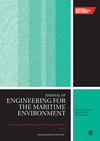利用 OVMD-FE-PSO-LSTM 方法预测极端海况下半潜式浮动风力涡轮机的 6-DOF 运动响应
IF 1.5
4区 工程技术
Q3 ENGINEERING, MARINE
Proceedings of the Institution of Mechanical Engineers, Part M: Journal of Engineering for the Maritime Environment
Pub Date : 2024-03-28
DOI:10.1177/14750902241239361
引用次数: 0
摘要
海上浮动风力涡轮机的运动响应对其结构完整性、发电效率、运行复杂性、安全性和稳定性有重大影响。因此,预测海上浮动风力涡轮机的运动响应至关重要。在工程实践中,尤其是在极端的海洋环境中,风力涡轮机的运动变得更加复杂,使得精确预测更具挑战性。在深度学习技术飞速发展的今天,针对这一问题已经出现了一些解决方案。本文提出了一种混合模型,即 OVMD-FE-PSO-LSTM 模型。我们首先对极端海况下的 5 MW-OC4 半潜式浮动风力涡轮机进行数值模拟,获取涡轮机六个自由度的运动数据。然后,我们使用优化的传统 VMD 方法分解初始运动数据,使用 FE 方法评估模态复杂性,合并复杂性相似的模态组件以减少计算负荷,并使用 PSO-LSTM 模型进行预测。最后,我们分析并比较了不同模型的预测结果。结果表明,所提出的混合模型在准确性方面优于其他比较模型,为预测海上浮动风力涡轮机的运动响应提供了新的见解。本文章由计算机程序翻译,如有差异,请以英文原文为准。
Prediction of 6-DOF motion response of semi-submersible floating wind turbine in extreme sea conditions using OVMD-FE-PSO-LSTM methodology
The motion response of offshore floating wind turbines significantly influences their structural integrity, power generation efficiency, operational complexity, safety, and stability. Therefore, predicting the motion response of offshore floating wind turbines is of paramount importance. In engineering practice, especially in extreme marine environments, the motion of wind turbines becomes more complex, making accurate prediction more challenging. In this era of rapid development in deep learning technology, some solutions have emerged for this problem. In this paper, we propose a hybrid model, namely the OVMD-FE-PSO-LSTM model. We begin by conducting numerical simulations of a 5 MW-OC4 semi-submersible floating wind turbine in extreme sea conditions, obtaining motion data for the turbine’s six degrees of freedom. We then decompose the initial motion data using an optimized traditional VMD method, assess the modal complexity with the FE method, combine modal components with similar complexity to reduce computational load, and make predictions using the PSO-LSTM model. Finally, we analyze and compare the predictive results of different models. The results demonstrate that the proposed hybrid model outperforms other comparative models in terms of accuracy, providing new insights into the prediction of the motion response of offshore floating wind turbines.
求助全文
通过发布文献求助,成功后即可免费获取论文全文。
去求助
来源期刊

CiteScore
3.90
自引率
11.10%
发文量
77
审稿时长
>12 weeks
期刊介绍:
The Journal of Engineering for the Maritime Environment is concerned with the design, production and operation of engineering artefacts for the maritime environment. The journal straddles the traditional boundaries of naval architecture, marine engineering, offshore/ocean engineering, coastal engineering and port engineering.
 求助内容:
求助内容: 应助结果提醒方式:
应助结果提醒方式:


